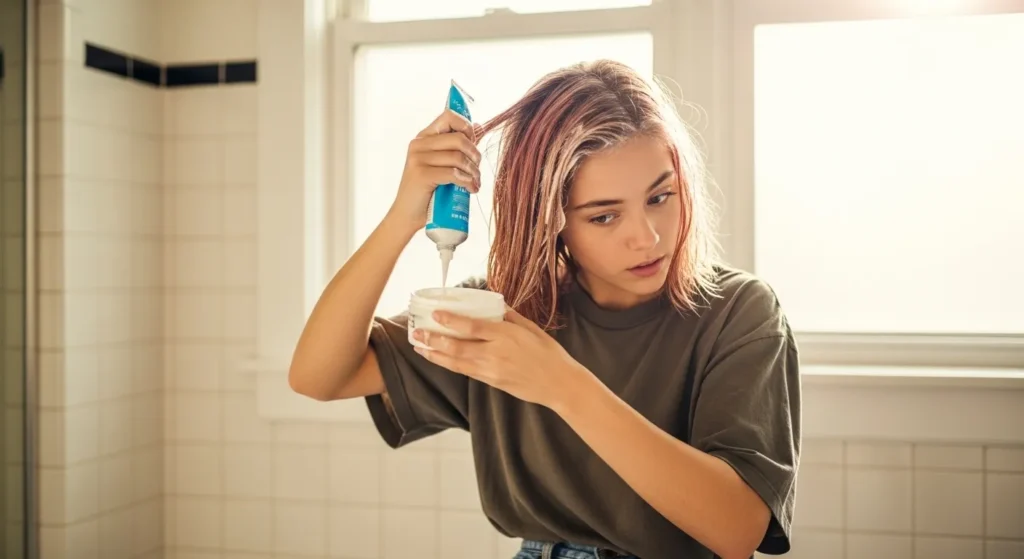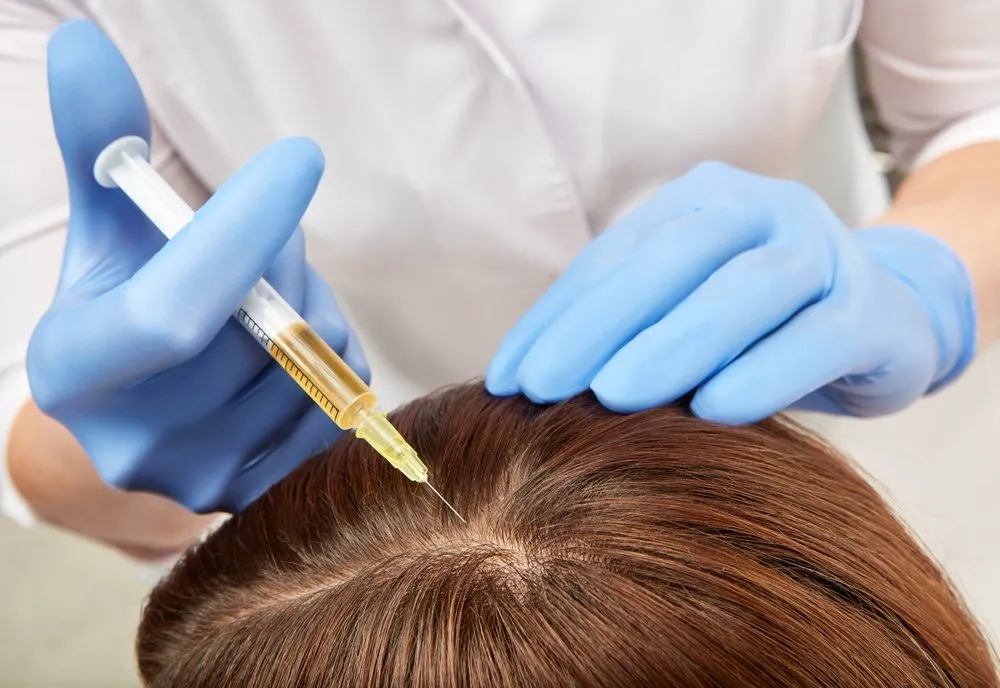Worried that bleaching your hair might lead to hair loss? You’re not alone. Many people wonder, will bleaching hair cause hair loss or just temporary damage?
This article dives into the science behind hair bleaching, how it affects your strands, and what you can do to prevent or recover from damage. By the end, you’ll understand the real risks, expert-backed solutions, and safe practices to keep your hair healthy, even when going blonde.
Understanding Hair Bleaching

What Is Hair Bleaching and How Does It Work?
Hair bleaching is a chemical process that strips the natural pigment (melanin) from your hair to lighten it. The main agents used are hydrogen peroxide and ammonia, which penetrate the hair shaft to remove color.
Common Chemicals Used in Bleaching Products
- Hydrogen peroxide – the oxidizing agent
- Ammonia – helps open the cuticle for pigment removal
- Persulfates – enhance lightning effect
These chemicals, though effective, can also damage hair structure if overused.
Why People Bleach Their Hair
Hair bleaching is popular for aesthetic reasons—be it a full platinum transformation or subtle highlights. Cultural trends and personal expression also drive this global hair coloring habit.
Does Bleaching Actually Cause Hair Loss?
Hair Damage vs. Hair Loss: What’s the Difference?
It’s important to distinguish between hair breakage (from shaft damage) and true hair loss (from follicle disruption).
- Breakage: Hair snaps due to weakness in the strand.
- Hair loss: Hair falls out from the root, often linked to scalp or follicle damage.
Bleaching does not directly cause hair loss from the root, but it can lead to breakage and shedding, giving the illusion of hair loss.
How Bleaching Affects the Hair Shaft vs. Follicle
Bleach targets the hair shaft, not the follicle. However, aggressive bleaching or improper use (especially DIY kits) can irritate the scalp and weaken follicles, potentially leading to thinning over time.
Is Hair Fall Temporary or Permanent After Bleaching?
In most cases, shedding after bleaching is temporary. Once the hair regrows and you maintain a good care routine, thickness can return. But repeated chemical exposure can cause long-term thinning or scarring alopecia in extreme cases.
Signs Your Hair Is Damaged from Bleaching
Increased Breakage and Thinning
If your hair feels brittle and breaks easily when combing, it’s a sign of over-processing. You might notice hair appearing shorter and uneven.
Scalp Irritation or Burns
Bleaching chemicals can burn or inflame the scalp if left on too long or used incorrectly. Redness, tenderness, and itching are warning signs.
Brittle Texture and Frizziness
Bleached hair loses natural moisture, resulting in a rough texture, a dull appearance, and frizzy ends.
Scientific & Expert Opinions on Bleaching and Hair Loss
What Dermatologists and Trichologists Say
According to hair specialists, excessive bleaching weakens the hair’s structure and can lead to telogen effluvium (stress-induced shedding). However, this is usually reversible with proper treatment.
Medical Citations or Studies on Hair Damage
Studies have shown that repeated use of bleach decreases hair tensile strength and alters cuticle alignment, leading to breakage.
Is There a Safe Amount or Frequency of Bleaching?
Professionals recommend spacing bleaching sessions at least 6–8 weeks apart, depending on hair type, to minimize cumulative damage.
Who Is Most at Risk for Bleach-Related Hair Loss?
People with Already Damaged or Thin Hair
If your hair is already weak from heat styling or previous dyeing, bleaching increases the risk of breakage and shedding.
Those with Scalp Conditions (Eczema, Psoriasis)
People with sensitive or inflamed scalps are more prone to chemical burns and follicular damage during bleaching.
DIY Bleach Users vs. Professional Salon Treatments
Home bleaching kits often lack precision. Professionals assess hair health and customize formulas to minimize harm.
Pro Tip: Always do a patch test before using any bleaching product.
How to Prevent Hair Loss from Bleaching
Pre-Bleach Hair Care Routine
- Use protein-rich masks to strengthen strands
- Avoid heat styling for 1 week prior
- Deep condition your hair a few days before bleaching
Choosing a Professional Over DIY Kits
Salons use quality products and techniques to minimize damage. They also monitor timing and scalp sensitivity.
Using Bond Builders and Deep Conditioning
Products like Olaplex or K18 rebuild hair bonds damaged during bleaching. Regular deep conditioning also helps restore moisture.
How to Treat Hair Loss or Damage After Bleaching
Natural Remedies and Protein-Rich Masks
Use masks with keratin, egg protein, or castor oil to help restore hair strength naturally.
Professional Hair Repair Treatments
- PRP (Platelet-Rich Plasma) for scalp rejuvenation
- Mesotherapy for follicle stimulation
- Low-Level Laser Therapy (LLLT) to promote growth

When to See a Hair Loss Specialist
If shedding persists beyond 6–8 weeks or you notice bald patches, consult a trichologist or certified hair transplant surgeon.
Expert Tips for Safe Hair Lightening
How Often to Bleach Without Damaging Hair
Experts suggest bleaching no more than once every 2 months, with restorative care in between.
Safe Alternatives to Traditional Bleach
- High-lift hair dyes
- Ammonia-free lighteners
- Balayage techniques (less scalp contact)
Post-Bleach Care Checklist
✅ Use sulfate-free shampoos
✅ Avoid heat styling for at least a week
✅ Apply leave-in treatments
✅ Get regular trims to avoid split ends
FAQs – Will Bleaching Hair Cause Hair Loss?
Can hair grow back after bleaching damage?
Yes, if the follicles are not permanently damaged, hair can regrow with proper care.
Is it normal to shed hair after bleaching?
Mild shedding is common due to breakage, but excessive fallout may indicate deeper damage.
Can I bleach my hair if it’s already thinning?
It’s risky. Speak with a hair specialist first and consider alternatives.
What’s the safest way to lighten hair without damaging it?
Use ammonia-free lighteners, do it professionally, and strengthen hair beforehand.
What You Need to Know About Hair Bleaching & Hair Loss
Bleaching your hair doesn’t directly cause hair loss, but it can result in serious damage, breakage, and shedding if done incorrectly. Understanding your hair type, using safe methods, and prioritizing aftercare are key to avoiding irreversible harm. Always consult a specialist if you notice unusual hair fall after chemical treatments.
Worried about hair thinning or shedding after bleaching?
Book a personalized consultation with Dr. Rana Irfan, ABHRS-certified hair restoration specialist in Islamabad. Get a detailed diagnosis and access safe, expert-guided treatments to restore your hair’s strength and confidence.
